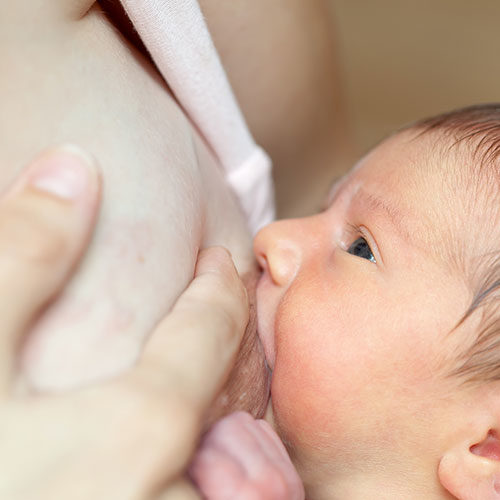Exclusive Expressing / Pumping
Exclusive expressing is the term to refer to providing breast milk for the baby by only expressing and offering. It does not involve direct breastfeeding. When a baby is unable to feed at the breast effectively, some mothers resort to providing breast milk to their baby by expressing.
Reasons for Exclusive Expressing:
- Exclusive expressing is an option which can be very helpful in certain conditions wherein the baby is unable to latch (due to unresolved ties, cleft palate or lip, a heart condition, low muscle tone, breastfeeding being emotionally triggering for the mother due to a history of abuse etc).
- Manyatimes, mothers begin to exclusively express, as a temporary solution to some challenges like separation from the baby, a nursing strike, latching issues etc. But in some cases, the temporary plan keeps extending as factors like nipple confusion and bottle preference come into the play.
- In some cases, mothers electively express their breast milk exclusively for their babies due to reasons like embarrassment of nursing in public or a belief that expressing and offering is easier than direct breastfeeding.
Direct breastfeeding can be way more convenient and easy as compared to expressing and offering as it completely eliminates the time and effort spent in preparation. Direct breastfeeding requires zero preparation. Exclusive expression of breast milk, to some extent, can restrict the benefits like saliva backwash (when baby’s saliva comes into the contact with the mother’s nipple, it sends signals about the specific requirements of the baby in terms of antibodies etc, which helps the mother prepare a completely customized milk for her baby). It can potentially impede an effective demand conveyance during growth spurts. The average duration of breastfeeding is much longer when the mother is breastfeeding directly as opposed to when she is expressing and offering. Considering a lot of things, it is always recommended to try and bring the baby back to the breast rather than embarking upon a long term journey of expressing and offering breast milk. However, when it is not possible, the decision to express exclusively comes from the understanding and acceptance of the fact that mother’s milk is irreplaceable. When expressing is the only way possible to provide breast milk for the baby, it is definitely the next best option and should be encouraged.
It is important to note that, There should be no guilt of not being able to nurse directly. Even though the importance of direct breastfeeding cannot be challenged, one must remember that – breast milk itself is just as important! The method of feeding is irrelevant when faced with a predicament of choosing between breast milk and its substitute.
Is it Possible to Exclusively Express Breast milk?
If a mother, for reasons of her own, decides to exclusively express, it is absolutely possible for her to provide for her baby. With the correct guidance, support and perseverance, a mother can even continue it long term.
Expressing or Pumping?
Expressing breast milk manually and providing for the baby is definitely possible. However, most mothers opt to pump. Pumping is faster, less energy-consuming, and more convenient. Electric pumps are even faster and easier to use than manual pumps. Double electric pumps, even more so! However, it completely depends on the mother which option she chooses. A lot of factors can contribute to her decision :
- How long does she plan to express
- Access to pumps, bottles and other equipment (steriliser etc.)
- Budget
- If a pump, which pump does her body best responds to
Based on her individual reasons and circumstances, a mother can either choose to hand express or pump. The schedule, frequency etc of both the methods remain more or less the same. For the specific techniques of hand-expression and pumping, our article on ‘Expressing Milk’ can be helpful.
How often to Express / Pump?
In the first 2-3 days after the birth of the baby, the mother produces colostrum (thick, yellowish milk in small quantities). Colostrum is most effectively removed by hand expression, since it is produced in small quantities. Starting from this stage, it is always recommended to mimic the nursing pattern of the baby. Therefore, it is important to hand express colostrum 10-12 times in a day (24 hours) at regular intervals. Usually, expressing breast milk every 2 hours works well. This also ensures an early transition to mature milk and the quantity of the mature milk in abundance.
Once the mature milk comes in, a pump can be used. Since the volume of milk increases along with the baby’s stomach capacity, using a pump can save time and energy. However, it makes sense to refrain from making a big investment in a pump until it is clear that the baby will not be directly breastfeeding. Reaching this decision may take a few days to weeks while trying to bring the baby to the breast. When a mother uses a pump, again, the frequency should mimic the average breastfeeding pattern which is 8-12 times in 24 hours. For the first few months, it is important to keep the intervals between pumping schedules more or less equal. That means, pumping every 2-3 hours rather than having certain pumping sessions having a gap of 1 hour and some upto 4-5 hours. Once the milk supply is established, one gap of 4-5 hours at night can be accommodated if it is not affecting the supply. However, it is recommended to have at least one pumping session between 2am to 5 am as between that time, the prolactin levels are highest, therefore increasing the milk production and consequently, the output.
How much to Express / Pump?
In the first couple of days, the baby takes small amounts of colostrum in each feed. Once the mature milk comes in, it usually flows in large volumes. Along rises the baby’s stomach capacity as well. Both, the baby’s intake and the mother’s milk production increases rapidly in the first couple of weeks.
In the initial weeks, many mothers notice that they produce more than the baby’s demands. This excess expressed breast milk should be stored in order to cope up with baby’s demands during times of growth spurt or illness (when the baby demands more than usual) or during other times when the mother has been unable to pump or unable to express the desired amount of breast milk.
Research has shown that an exclusively breastfed baby between the age of 1 to 6 months drinks an average of about 750-800 ml milk in 24 hours. The range is from <500 to >1000 ml. Each child is different and there is no one rule that can fit all. So, it is best to follow the baby’s lead and aim to pump as much as the baby requires on an average. Once the baby has completed 6 months and solids are introduced, the breast milk requirement may gradually drop marginally. However, it is important to remember that breast milk is the main source of nutrition for the baby until she is 1 year old and therefore, the amount of breast milk the mother needs to express will remain approximately the same till the baby turns 1.
Duration of each Pumping Session:
There are conflicting recommendations around this. However, what makes most sense is that each mother is different from one another with their own unique storage capacity of breasts, unique milk-making capacity, unique demands from their babies, unique let down reflex etc. Other factors affecting the duration are the time of the day/night, type of pump used, settings on the pump etc. Therefore, there cannot be a standard recommendation for all. However, a range of 20 to 40 minutes is suggested by experts. As a thumb rule, one should continue to express until the milk stops flowing. Once milk stops flowing, pumping should be continued for a couple of more minutes to check if another let down occurs.
If a mother is looking to increase her supply, she should pump for another 5-10 minutes for more stimulation.
If a mother is looking to decrease her supply, she could gradually reduce the length of her pumping sessions over time.
Tips to Keep up with the Baby’s Demands while Exclusively Expressing / Pumping:
- Always mimic and mirror the baby’s feeding pattern. Responsive feeding translates to responsive expressing/pumping in case of expressing/pumping mothers. If the baby is demanding to be fed more often, include more pumping sessions in the schedule. Adding pumping sessions is more effective than increasing the duration of pumping sessions.
- Be vigilant for signs of growth spurts. Include more pumping sessions to keep the supply up.
- Consume galactagogues, if necessary. Some women experience a dip in their supply around their periods. Galactogogues are a great way to handle the dip and to meet the baby’s needs during such times.
- Whenever there’s excess milk, always store it in small batches in order to use it at a later point when needed.
- Always hand express at the end of a pumping session. This helps the breasts drain completely, allowing them to fill faster.
Tips to Increase the Expressing / Pumping Output:
- Massage the breast(s) before expressing/pumping.
- If possible, do skin to skin with the baby while pumping.
- If the baby is away, keep a photo of the baby in front or smell her clothes while pumping.
- Relaxing, taking a warm shower, listening to soothing music etc. before pumping can release oxytocin – the hormone that helps trigger the let down (ejection) of milk.
- Covering the bottle with a sock or a bottle-cover to avoid looking at how much milk is being expressed is a good idea for those who get anxious by looking at the quantity of breast milk expressed.
- Observe what time of the day you have maximum output and try to take advantage of that.
- Prolactin levels are highest during early morning hours. Use that time to get more output.
- Understand the settings on your pump and use the right combination of stimulation and suction for yourself. Experienced pumping mothers recommend using the suction strength set at ‘minimum’ rather than ‘maximum’ for more output.
- Make sure that hand expression or pumping is not painful at all. Pain inhibits oxytocin, resulting in a slower let down and less output.
- Power-pumping is an effective way to increase supply and output. It involves pumping at smaller intervals within a given time. E.g. instead of pumping once every 2-3 hours, pump every half an hour within those 2-3 hours. Such cluster pumping boosts the supply and increases output.
Other Tips for a Successful Expressing / Pumping Journey:
- Both hand expressing and pumping take some getting used to. Trying different techniques and trying different pumps help understand which pump your body responds to the best. Some research and trial is important before investing in a pump.
- Understand the technicalities of using a pump well. Its settings, assembling, flange size, availability of spare parts etc are important factors that need to be considered.
- Talk to other mothers who are exclusively expressing/pumping. Exchanging techniques is a good way to learn and enhance the process..
- Seek professional help and guidance from lactation specialists, if required.
Storing Expressed Breast Milk:
While exclusively expressing/pumping, there is a good chance for the expressed breast milk (EBM) to be used up within a few hours of expressing it. EBM stays fresh at room temperature for 4-6 hours. If the baby is going to consume the EBM within that time frame, the milk can be kept at room temperature itself. Fresh milk is always preferable over frozen milk.
The left-over milk (if not touched the baby’s mouth/saliva), can be stored in the refrigerator to be used within the next 24 hours. If the milk is kept in the back of the refrigerator and the temperature is maintained at 4 degree celsius, the milk can be stored for 4 days.
If a mother is producing a lot more than what her baby needs, she could either donate that milk to a milk bank or freeze that milk to be used in future. Frozen milk can be consumed even after 6 months of freezing. More information can be found in our article ‘Expressing Milk’ here.
Offering Expressed Breast Milk:
It is important to note that human breast milk separates into layers when kept in a container. The fat separates itself. This doesn’t mean the milk has gone bad. All you need to do is gently swirl the bottle to mix the fat component back. A bottle of breast milk should never be shaken violently to mix. Also, breast milk should never be exposed to direct heat (on a gas stove) or a microwave. EBM should be brought to desired temperature by putting the bottle full of EBM into another container filled with warm water.
Expressed breast milk can be offered to the baby via several modes. Bottles are most extensively used of all. However, bottle feeding comes with its own risks. Please see our article on ‘Alternatives to Bottles’ to explore options like paladai, open cups, shot glasses, spoons etc.
If a mother chooses to offer her EBM in bottles, it is important to use the slowest flow teat and to follow the paced bottle feeding method in order to minimize nipple confusion and bottle preference (keeps the option of bringing the baby back to the breast alive) as well as overfeeding. This method allows the baby to control and regulate her intake. This method essentially mimics the way a baby nurses at the breast. More information can be found at the following links:
- http://nurturedchild.ca/index.php/2010/12/10/baby-led-bottle-feeding/
- https://www.youtube.com/watch?v=UH4T70OSzGs&feature=youtu.be
Stopping to Express / Pump:
Just like weaning, expressing/pumping should be stopped gradually. Dropping one expressing/pumping session at a time, every few days makes the transition smoother. Other methods include increasing time intervals between sessions and reducing the duration of each session. None of it should be rushed up. A mother can completely stop expressing / pumping over a few months.
References:
https://www.breastfeeding.asn.au/bfinfo/exclusive-expressing
https://www.laleche.org.uk/exclusively-expressing-breastmilk-for-your-baby/
https://kellymom.com/mother2mother/exclusive-pumping/
https://www.llli.org/life-as-an-exclusive-expresser/
http://nurturedchild.ca/index.php/2010/12/10/baby-led-bottle-feeding/
Wish to speak with a member of our team who is a certified lactation professional and also an experienced breastfeeding mother, click on this link.
Medical Advice Disclaimer
THIS WEBSITE DOES NOT PROVIDE MEDICAL ADVICE.
The information, including but not limited to, text, graphics, images and other material contained on this website are for informational purposes only. No material on this site is intended to be a substitute for professional medical advice, diagnosis or treatment. Always seek the advice of your physician or other qualified health care provider with any questions you may have regarding a medical condition or treatment before undertaking a new health care regimen, and never disregard professional medical advice or delay in seeking it because of something you have read on this website.
Disclaimer
We understand and acknowledge that parents and babies can be of various genders on a spectrum of LGBTQI+. Families come in diverse flavours. However, in our articles, for the sake of simplicity and convenience, we will be referring to the breastfeeding parent as the mother and using the female pronouns- ‘she’ and ‘her’ for babies. Babies can be nourished and nurtured in different ways and while we have used the terms breastfeeding and nursing, we recognize that parents can opt to chest feed or finger feed.
We don’t have conflicts of interest and declare, and we are compliant with the WHO code of marketing of breastmilk substitutes and the IMS act.
In case you find any information on this website that needs to be updated, please write to us at info@bsim.org.in






